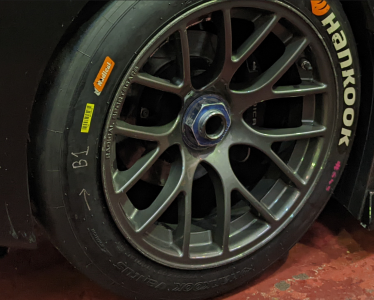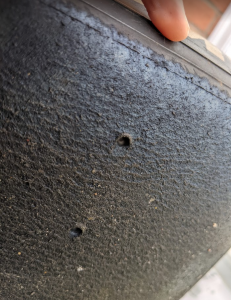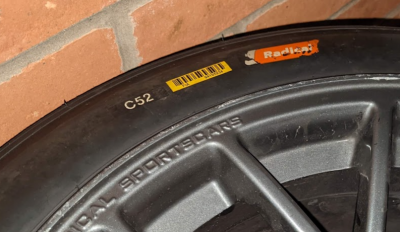
Tyres - when to change
below is a pic of the rear right, a picture i took over a year ago now when i picked up the car.
I only just noticed...today.. the 'rotation' word imprinted on the tyre and what looks like a directional arrow. To me, the 'pointing head' of the arrow is pointing in the opposite direction to whoever painted the white arrow on.
The rear-left is also consistent. So my first question is..... which way are you supposed to read the Rotation "arrow" on the tyre, because to me it's counter-intuitive, if indeed the tyres are on correctly. Or have i been running the tyres in the opposite direction to their rotation this entire time? or does it even matter?
My second question.. these slicks have now gone through 2 winter storages sat in 0-5 degree C temps for mabye a month during the coldest periods of the british winter. DUring 2022 i only managed 5 days of running in the car, i was happy with the level of grip/consistency.
They appear to have some tread left. Would i get considerably more grip by swapping to a fresh set? Like....how much would we be talking, 1 second? 1.5? 2?!
there's a pre season test at silverstone at the end of March and i'm considering whether to splash out on fresh rubber for it or not bother.
question 3 - how can i tell what compound they are? They have a 'C52' sticker on them. Hankook website has C5 as the Medium compound code...but what would the '2' signify? or is there something else that tells me what the compound is, coz i can't see another reference label that corresponds with the size/compound reference table on the website.
- Rotation: I don't think it matters on the slick.
- New tire difference: 1-2s lap time is about right. It depends on the track and your ability to take advantage of the additional grip. Once you taste it though ... it's addictive.
If you're not competing, I'd recommend spending the $$$ elsewhere. You can buy a Garmin Catalyst for the cost of a set of new tires and possibly gain that 1-2s in driver mods that'll carry forward with you forever.
- Compound marking: dunno. we only run 1 compound so I've never looked
The tires are directional marked. I talked to Hankook about this exact subject, they said the tires are intended to run in proper noted direction for the 1st heat cycle only. After that, they can be moved around as desired. Something about setting the compound correctly during first cycle.
For me, I dont count days or time, I count heat cycles for my tires. I have heard amazing stories of people running these tires for 50-70 cycles each. For me, never, like most slicks, the grip is diminishing after the first 5-7 cycles from brand new. Then, just a question of how hard and/or competitive you want to be. I discard my tires at ~24 cycles even though they still have substantial thread thickness remaining, but because the grip level has gotten undesirable versus fresh rubber.
C52 is the standard medium compound that is most available. They also have C72? that is softer compound.
Not positive about the C52, I have only ran them on a comp car once but for Pirelli DH/DHb Michi's and Yokohama slicks (anything but the soft compound) I can say that mid-level GT car cup race teams tend to take them off after 30-40 laps after being used by gentleman semi-pro drivers. They still have plenty of life in them after that but data numbers start to degrade and fall out of the window for testing data purposes. If its a race used tire, typically drivers stent max-time rules during races preclude them from going much further than that same 30-44. There is a large aftermarket for used racing slicks that these raceteams consider 'done'. They can normally go another 5-15 HPDE heat cycles after that and still run some pretty respectable, but not competition edge, times.
As for tires on the radical they are much less stressed as far as rubber degradation and power are concerned so the factor comes down to heat cycles. After many warm up/cool downs the elastomers in the rubber become hard and set making the tire less gummy. You may have a case where the tire wear indicators look fine to the eye to but has given up the ghost in heatcycles. Using tire warmers on our light cars to maintain temps of the rubber after and between session can gain you time on slicks since you never let them 'cool' down all the way. For the same reasons leaving a tire in the direct sun and cold for storage can degrade then as-well.
My tires look almost exactly like yours in terms wear and I've used them for about 20 cycles. I just use my car for track days and don't race so they've been fine. Right now, the limiting factor to faster lap times for me is not the tire but my own confidence and ability.





